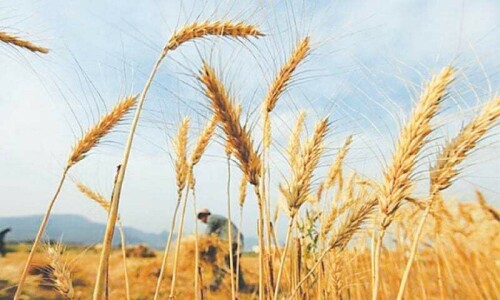**The Growing Challenge of High Production Costs in Pakistan’s Agriculture**
Pakistan’s agriculture sector is currently facing its most pressing challenge: the escalating cost of crop production. In recent years, the prices of key agricultural inputs—such as electricity, petroleum products, fertilizers, and pesticides—have risen sharply, making it increasingly difficult for farmers to manage their production costs. Unless these issues are addressed, the government’s goals of promoting agricultural growth, controlling inflation, and keeping food prices affordable will remain out of reach.
The issue came to a head in July 2024, when the Punjab government set district-specific wheat prices between Rs2,800 and Rs3,050 per 40kg, a price well below the farmers’ production cost of over Rs3,000 per 40kg. This highlighted the growing gap between the cost of production and the price at which farmers are able to sell their crops.
Farmers, understandably, often advocate for subsidies on agricultural inputs to help reduce their burden. However, given the country’s current fiscal constraints and the conditions attached to the ongoing International Monetary Fund (IMF) program, it is unlikely that direct or indirect subsidies can be extended to farmers in the foreseeable future.
Despite these constraints, there is still significant potential to reduce overall production costs and increase crop yields through strategic interventions that improve the efficiency of agricultural inputs, enhance productivity, and minimize losses.
### Tackling Structural Inefficiencies
A major factor driving up production costs is the inefficient use of agricultural inputs. Fertilizers, for example, are often applied inefficiently, with significant amounts lost through leaching or evaporation, especially when broadcast or flooded. In many cases, the type, timing, and quantity of fertilizer applied are not aligned with the specific needs of the crops. This contrasts with practices in neighboring countries like India, where soil testing is routinely conducted under the Soil Health Card Scheme, ensuring more effective fertilizer application. In Pakistan, however, less than 1% of farmers test their soil.
Water-use efficiency is another critical area where Pakistan lags behind. The country’s water productivity—measured as the quantity of crops produced per unit of water—is much lower than in other countries, largely due to inefficient flood-irrigation practices, low crop yields, and limited adoption of technologies like land laser leveling. Farmers often lack the necessary tools and knowledge to assess crop irrigation needs accurately, and losses in farmer-managed watercourses are exacerbated by poor de-silting and inadequate weed removal.
Similarly, pesticide use in Pakistan remains largely indiscriminate, with farmers relying on chemical applications instead of adopting integrated pest management (IPM) practices. Many farmers are unaware of key factors like economic threshold levels, proper spray machine settings, and nozzle types, resulting in ineffective pest control that drives up both production costs and crop losses.
### Addressing Crop Losses and Improving Harvesting Practices
Crop losses during production, harvest, and post-harvest stages also contribute significantly to high costs. For example, wheat and rice often suffer from lodging, which reduces yields. This issue underscores the need for shorter-stature, climate-resilient crop varieties that can withstand the increasing threats posed by climate change. Unfortunately, most of Pakistan’s crop varieties are medium-to-long-duration, which not only increases production costs but also heightens vulnerability to climate-related risks.
In addition, outdated harvesting equipment, such as combine harvesters from the 1980s and 1990s, causes substantial crop losses—up to 20% in some cases—due to improper calibration and settings. To reduce such losses, there is an urgent need to modernize harvesting practices and machinery.
### Strategic Interventions for Cost Reduction
Despite the challenges, there are several strategic interventions that can help reduce production costs and improve productivity:
1. **Climate-Resilient, High-Yielding Varieties**: There is a need to enhance the availability and adoption of short-duration, high-yielding, climate-resilient, and short-stature crop varieties. This requires targeted policy measures and institutional and financial support to ensure these varieties reach farmers.
2. **Revamping Agricultural Extension Services**: The agricultural extension services provided by provincial departments have failed to deliver significant results, mainly due to poor coverage, inefficiency, and lack of effectiveness. To improve outcomes, these services need a complete overhaul, with a focus on modernizing their design, implementation, and outreach efforts.
3. **Affordable Mechanization**: Shrinking farm sizes have made it difficult for smallholders to invest in expensive farm machinery like tractors. While rental services have expanded, they are increasingly unaffordable for many smallholders. To address this, cooperatives—preferably run by professionals and operating on commercial principles—should be promoted to facilitate affordable mechanization in rural areas.
4. **Adopting Regenerative Agriculture**: Practices such as minimum tillage, crop diversification, water stewardship, relay cropping, and biodiversity preservation can significantly reduce costs related to land preparation, irrigation, fertilizers, and pesticides. Additionally, promoting perennial forages and ratooning crops—which allow for multiple production cycles without replanting—can be beneficial.
### Conclusion
The key to reducing agricultural production costs and improving competitiveness lies in addressing the sector’s structural inefficiencies. Pakistan must embrace modern technologies, improve agricultural extension services, and adopt sustainable farming practices to make the agriculture sector more efficient and resilient to climate change. Failure to do so will not only erode export competitiveness but will also make it increasingly difficult to maintain affordable food prices for local consumers.
*Khalid Wattoo is a farmer and development professional, and Dr. Waqar Ahmad is a former Associate Professor at the University of Agriculture, Faisalabad.*



